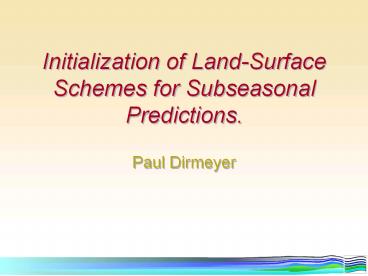Initialization of Land-Surface Schemes for Subseasonal Predictions. - PowerPoint PPT Presentation
Title:
Initialization of Land-Surface Schemes for Subseasonal Predictions.
Description:
Land surface 'memory' is concentrated in the sub-seasonal time-scale (0-3 months) ... Courtesy Eleanor Burke. Ruth DeFries via Tom Jackson. Independent data sets ... – PowerPoint PPT presentation
Number of Views:24
Avg rating:3.0/5.0
Title: Initialization of Land-Surface Schemes for Subseasonal Predictions.
1
Initialization of Land-Surface Schemes for
Subseasonal Predictions.
- Paul Dirmeyer
2
Soil moisture decorrelation time-scales
- Land surface memory is concentrated in the
sub-seasonal time-scale (0-3 months). - Land surface memory is an ideal piece of
potential predictability to be harvested for
sub-seasonal forecasts.
3
Goal of land initialization
- Consistency across models (same anomalies)
- Consistency within model (between initial land
state and land model)
4
Sources of initialization
- Observations
- Independent data sets (from a different model
than yours) - Consistent offline data set (from your land
model) - Coupled LDAS (your land and atmosphere models)
5
Snow Mass
Monthly Nimbus-7 SMMR data on a 30-minute
latitude/longitude grid
- Cannot measure directly from satellite, although
snow cover can be well determined. - Must estimate coverage, e.g.,
6
Soil Temperature
- Very few and scattered soil temperature
measurements. Big gaps exist in current
networks.
7
Soil Wetness
In situ measurements
Global Soil Moisture Data Bank
- Very few and scattered soil wetness measurements.
Some of the best long-term networks have decayed
in last decade. Still gaps.
8
Soil Wetness
Courtesy Eleanor Burke
Remote sensing
- Remote sensing limited to very near surface and
vegetation-sparse areas.
L-band TB 0 look angle ½ resolution
Ruth DeFries via Tom Jackson
9
Independent data sets
- Combine meteorological observations (forcings)
with a model of the land surface - Mintz and Serafini
- Schemm et al.
- Schnur and Lettenmaier
- Willmott and Matsura
- Huang et al.
- Dirmeyer and Tan (GOLD)
- Current Land Data Assimilation System (LDAS)
products
10
Independent data sets
- Huang and van den Dool
NCEP/CPC
11
Independent data sets
- Land Data Assimilation System (LDAS) no
assimilation
N-LDAS
12
Independent data sets
- All have a basic shortcoming the product is
from someone elses model
- Soil wetness is not easily transferable between
models.
Koster and Milly
13
Consistent offline data set
- Global Soil Wetness Project (GSWP)
- Historical
- Land Data Assimilation System (LDAS)
- Real Time
Uses observed/analysis meteorological forcing to
drive your land model uncoupled from atmospheric
model. Generates land surface state variables and
fluxes for best-possible atmosphere, but without
feedback processes. True LDAS will also
assimilate land surface state variable
observations.
14
Global Soil Wetness Project (GSWP)
- Your model must be in the project to generate the
initial conditions.
COLA/SSIB
15
LDAS Approaches
- US (North American and Global)-LDAS approach
- Assimilation of observations of soil temperature
and moisture - Strictly uncoupled from atmosphere
- Multi-model
16
LDAS Approaches
- European-LDAS approach
- Relaxation of coupled PBL to observations
- Assimilation of observations to nudge soil
moisture - Multi-model
17
Coupled LDAS
- Land model is coupled to its parent atmospheric
model during integration. - Shortcomings of atmospheric model fluxes
(precipitation, radiation) are overcome by some
intervention - Replace downward fluxes (poor-mans LDAS)
- Flux adjustment (similar to ocean-atmosphere)
- Empirical correction of state variables
18
POOR MANS LDAS A study of the impacts of soil
moisture initialization on seasonal forecasts
At every time step in a GCM simulation, the land
surface model is forced with observed
precipitation rather than GCM-generated
precipitation. The observed global daily
precipitation data comes from GPCP and covers
the period 1997-2001 at a resolution of 1o X 1o
(George Huffman, pers. Comm.) The daily
precipitation is applied evenly over the day.
19
(No Transcript)
20
(No Transcript)
21
Compromises
- None of the above methods combine the key
elements necessary for initialization of a broad,
voluntary, multi-model experiment - Easy
- Cheap
- Fast
22
Compromises
- Possible Solution
- Composite soil wetness
- Interannual anomalies from an agreed-upon
quasi-observed product - Mean annual cycle from your land model (e.g.,
from AMIP-2, C20C, etc.)
23
Compromises
- Key questions
- How to scale the soil wetness (and snow)
anomalies to be consistent with your model? - Water mass but soil capacities may not agree
24
Compromises
- A better solution
- Interannual standard deviation
Standard normal deviates
but AMIP coupled L-A variance may be poor
March 1, 2002 soil wetness anomaly (percent of
saturation) for a) Huang et al. (1996) and b)
COLA GCM initial condition.
Origins of the Summer 2002 Continental U.S.
Drought M. J. Fennessy, P. A. Dirmeyer, J. L.
Kinter III, L. Marx and C. A. Schlosser 2002
Climate Diagnostics and Prediction Workshop,
Vienna, VA.
25
Vegetation
- Good estimates of vegetation phenology exist from
remote sensing (NDVI ? LAI, Greenness). - Hindcast climatology versus observed
- Forecast climatology versus persisted anomaly































